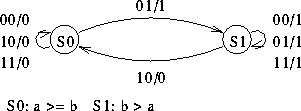 , otherwise 1.
, otherwise 1.
Tom Kelliher, CS 220
Nov. 7, 2001
Read 5-1,2.
Sequential circuit design.
Registers
Inputs: A, B, (no more msb). A and B are received least significant bit
first. Output 0 if  , otherwise 1.
, otherwise 1.
Reset to S0 on reset.
State diagram:

Things to observe:
b <= a; c <= b;does not behave as it would in C.

Compare process inputs to sensitivity lists.
-- VHDL for serial comparator. The inputs a and b are input lsb first.
-- The Mealy machine uses rising edge sensitive flip-flops and an
-- asynchronous active low reset.
--
-- The output is 1 if b > a, otherwise 0.
--
-- Note: The reset will not simulate properly in functional simulation.
-- It will simulate properly in timing simulation, once an
-- implementation has been created.
library ieee;
use ieee.std_logic_1164.all;
entity comparator is
port
(a, b, clk, reset : in std_logic;
o : out std_logic
);
end comparator;
architecture process_defn of comparator is
-- Two states needed.
type state_type is (S0, S1);
-- State assignment.
attribute enum_encoding : string;
attribute enum_encoding of state_type :
type is "0 1";
signal state, next_state : state_type;
-- For convenience, concatenate a and b.
signal inputs : std_logic_vector (1 downto 0);
begin
-- Concurrent assignment executes the rhs changes.
-- Concatenate a and b into inputs.
inputs <= a & b;
-- Processes execute whenever something on their sensitivity list
-- changes. All assignments take place when the process exits.
--
-- This process implements the D flip-flop.
state_register : process (clk, reset)
begin
-- If/else construct only valid within a process.
if (reset = '0') then
state <= S0;
elsif (clk'event AND clk = '1') then
state <= next_state;
end if;
end process;
-- This process computes the next state.
next_state_process : process (inputs, state)
begin
case state is
when S0 =>
if (inputs = "01") then
next_state <= S1;
else
next_state <= S0;
end if;
when S1 =>
if (inputs = "10") then
next_state <= S0;
else
next_state <= S1;
end if;
end case;
end process;
-- This process computes the output.
output_process : process (inputs, state)
begin
case state is
when S0 =>
if (inputs = "01") then
o <= '1';
else
o <= '0';
end if;
when S1 =>
if (inputs = "10") then
o <= '0';
else
o <= '1';
end if;
end case;
end process;
end process_defn;
Serial comparator. Inputs: A, B. A and B are received most significant
bit first. Reset to initial state on reset. Output 0 if  ,
otherwise 1.
,
otherwise 1.